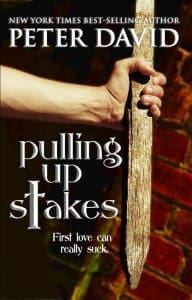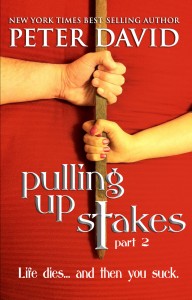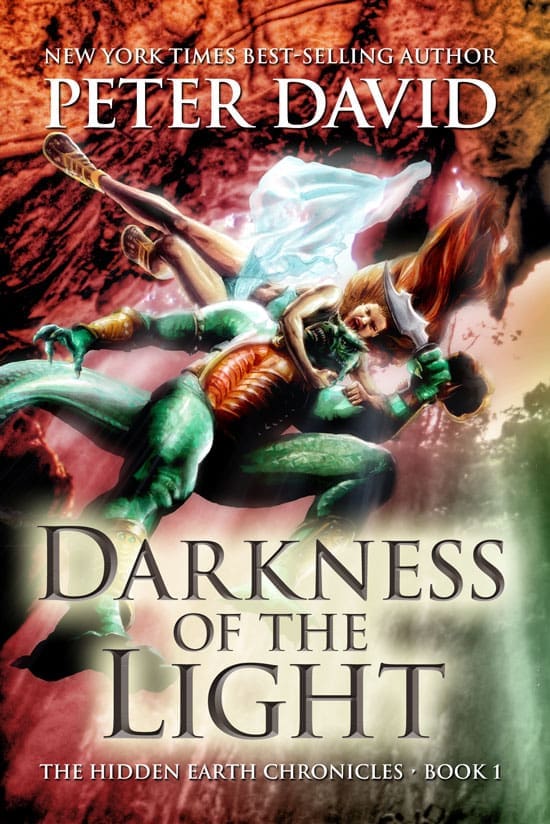 Originally published July 9, 1993, in Comics Buyer’s Guide #1025
Originally published July 9, 1993, in Comics Buyer’s Guide #1025
Concluding the printing of my journal from my sojourn to Romania for the filming of Trancers IV & V.
When last we left me, I was in the middle of an elaborate practical joke in which we had convinced one of the actors that I was Romanian; and I had just shared in a meal prepared in questionable fashion by the crew consisting of questionable fish caught from a questionable lake.
MAY 17–No sign of food poisoning. I lucked out.
As Vlad-the-Romanian, I climb into the morning van to the studio. Laughlin and his girlfriend, Sharon, are waiting. The Romanian driver says something to me in his native tongue. I reply in Romanian that my book is mineral water. We’re on our way.
The driver pushes matters through the ride, tossing occasional comments my way. I pull replies off storefronts and billboards. He asks me something. My answer: “Milk Products.” That sort of thing.
The shooting day progresses, and I’m still Vlad. Tim Thomerson is playing along with particular enthusiasm, engaging me in my broken English conversations and loudly denouncing me “behind my back” (since, presumably, I can’t understand him) as “a weird motherf—–.”
Finally director Dave Nutter, having gotten Laughlin’s main scenes out of the way, helps me spring it. Now we find out whether he knew or not.
With camera rolling after a completed take, I step onto camera with Laughlin. Dropping the accent, I say, “So did we fool you? Or did you know all along?”
He stares at me uncomprehendingly. I know in a heartbeat that we got him. He is unquestionably a talented actor, but nobody is that good that they could fake that stunned an expression. He is utterly shocked.
The crew is howling. Laughlin doesn’t understand what the hëll has happened to my accent. He tells me later that for an instant, he was convinced that nobody on the entire crew was actually Romanian, so confused had we made him. “I’m the writer,” I tell him. The camera’s rolling. He starts to laugh in amazement… he can’t believe that this elaborate a gag has been staged purely for his benefit. “Was Sharon in on this?” he demands. No… she is in the next room, watching the monitor with her jaw around her ankles.
He takes it extraordinarily well… much better than I would have, in all likelihood. Especially when I make it clear to him that it was nothing personal. The gag, which just sort of evolved, would have been pulled on whatever actor had been brought in. He also seemed, to me at least, a lot more relaxed the rest of the shooting day. All in all, a very worthwhile practical joke, because no one was hurt by it and it pulled a lot of folks together.
The kicker is that I learn later that Sharon had said to Laughlin, “You know, I’m not sure if I like Tim. He’s being very mean to Vlad.”
Joe, the make-up guy, helps me out so that I finally meet F. Murray Abraham, who says I should call him Murray. “Not F?” I ask. No. Murray. I tell him I write comic books. He tells me that his son is a comic book enthusiast. I offer to sign a comic to his son if I can have my picture taken with him. No sweat.
I go over to the set for Nostradamus. They have a library set that has to be at least five times the size that our library set was. It’s amazing what $20 million can do. I give him the comic, sign it to his son (hey, maybe he’s reading this. Hi, Mick. Your dad’s a really nice guy), get my picture taken with Murray, get yelled at by the assistant director because I didn’t ask his (the A.D.’s) permission to come on the set. I tell him I didn’t know, and I’m sorry. He says I should have asked his permission. I tell him I didn’t know, and I’m sorry. He says I should have asked his permission. By this point I’m ready to knock his block off, because how many times am I supposed to apologize? Now I know what $20 million can get you besides great sets: bìŧçhÿ assistant directors.
Back on our own set, we film a sequence where a time warping watch that Jack Deth wears backfires on him. Ideally, it slows the rest of the world down while Jack remains unaffected. In the previous three films, it’s been done by overcranking the camera so Jack moves in slow motion, while the rest of the world comes to a halt. Catering to Tim’s gift for physical comedy–which he never gets to display as Jack Deth–I flipflop it. In the scene, Jack is faced with a group of enemies and activates the watch. He moves in slow motion…
And his enemies are unaffected. As Tim moves at a snail’s pace, the others circle him in befuddlement. “Is this some bizarre attempt at levity?” asks one in confusion. Since they’re moving at normal speed, they knock him out with no problem. Tim does the longest collapse into unconsciousness in film history. With music and sound effects, it should be a high point of the film.
I have dinner with Laughlin and Sharon. They’re really good kids. Laughlin was in one of the best scenes in Unforgiven… the sequence where the first of the two cowboys that Eastwood has been hired to kill is gunned down. It’s an unforgettable scene. As the young cowboy lays dying, his friend makes a desperate attempt to aid him. The friend is Laughlin. The one who was shouting, “Don’t you shoot me, you bášŧárdš!” as he rushed to aid his friend as best he could, and wound up having him die in his arms. Very emotional.
Most of his Trancers work is done. I may not see him again while in Romania, but we part friends… although if we’re on the same set on another film, I’ll probably be watching my back…
MAY 18–An off day. I spend a portion of the day shopping, with the aid of a guide assigned by the production office. His name is Adrian. Adrian brings me to various stores in Bucharest. I can’t find anything made in Romania. Turkey, England, Italy, yes, but not Romania. Adrian tells me I wouldn’t want anything made in Romania, so shoddy is the workmanship.
Adrian dreams of taking his wife and child and moving to America. He tells me that if he could spend the next five years of his life in the United States, he would die happy. It’s a remarkable comment on his desire to get out of Romania. We drive past people lined up about thirty deep… for milk. There’s another line elsewhere of similar length, for bread. I can walk into a 7-11, in and out, in two minutes, buying whatever brand of milk or bread I feel like, and these people have to devote as much as five hours to a similar purchase, with no choice. Here it is. Your bread. Your milk. What kind of milk or bread? You’re kidding.
It harkens to another conversation I had with another young employee, Dragos, two days previously. He’s twenty years old. He’s an artist, who loves to do fashion designing. He wants to come to America to make his fortune. But he’s stuck where he is. He estimates the cost of an air ticket, plus visa, will take him about ten years to earn. By that time he’ll be thirty: Not quite as easy to start a new life as when he’s twenty. Plus he needs someone to sponsor him. In America, people dream of fame, fortune. In Romania, people dream of America. One major step removed, a xerox of a xerox. The picture that much faded, its definition vague.
He asks me, out of curiosity, how long it takes me to earn $1000. I lie, telling him I have no idea. “Six months?” he asks. I nod, knowing that the true answer is more like a fraction of that time. I try to explain that even though pay is higher in the States, everything costs more, too. That doesn’t seem to matter to him. Maybe he can’t quite comprehend it. All he cares about is his dream… a dream he very likely will never achieve.
I want to tell him I’ll help him. Write a check to cover airfare and visa. Say that I’ll sponsor him. I could help him. I could do it in a heartbeat.
But then there’s Adrian and his family. Or any of the half-dozen other Romanians I’ve spoken to, who have expressed similar desire. How can I say, “I’ll help this person, but not that one”? Feeling like I’m carrying a guilty secret, I tell him that I hope it all works out for him.
It serves as a reminder of how lucky I am. I’ve reached a certain station in life because of happenstance. I have a God-given talent, and I was born in the right place at the right time. Right now in Romania may be writers and artists who could leave in the dust everyone presently working in comics. Talented people, dreaming of fame and fortune. And all they will ever have are dreams.
MAY 19–I’m spiraling downward, from people with hopeless dreams to people with no dreams.
We have moved to our first location shooting, and there are no chairs anywhere for the cast. I commandeer a driver to take me to a department store, where we can buy some folding chairs.
Outside the department store, I spot a beggar. Not a “homeless person” or an “indigent” or any name that takes the sting out of it. A beggar. At first I don’t comprehend what I’m seeing. The old man is wearing his shirt open, and appears to have a flesh-colored snake around his shoulder, moving and twitching spasmodically. My guide is not getting too close. I stay back, pull out my camera and zoom in so that I can understand what I’m viewing.
Most of his right arm is gone. The bare flesh is flapping around like a bony kite stuck on a tree.
I’m on autopilot. I snap his picture, feeling unclean, and go over and put 500 lei in his box to try and wash myself.
We go into the department store, take the escalator to the third floor. As we pass the second, I can’t believe what I see.
A child, a girl, somewhere between five and eight years old, is following her mother, calling after her. Her skin is dark. She might have been beautiful, if given a chance.
She is on her knees. Walking on her knees.
Sort of.
Her legs don’t bend back. They are bent forward, at the knees.
Her body is teetering at about an 80 degree angle, like a Gumby or a collapsing marionette. She half-pulls, half-shuffles along, sliding on her calves.
My guide sees what I’ve spotted. His face is impassive.
“What the hëll is wrong with her?” I whisper. Grasping at the only explanation I can, I say, “Chernobyl?”
“Gypsies,” he replies.
I don’t understand, and tell him so.
“You see a lot of gypsy children like that,” he explains. “When they’re a few months old, sometimes their parents break their knees or their elbows, or put out an eye. They figure it will help them make more money when they beg.”
I nod.
We are looking at chairs, but I’m picturing a child who looks like my eight-year-old daughter, walking on reversed knees, calves scraping along the floor making sounds like sandpaper. We are buying the chairs, but I’m picturing a baby who looks like the smiling one waiting for me at home, howling as a mallet or a sledge hammer or maybe a jagged rock shatters her joints.
We get the chairs, and go out a different exit. There’s another gypsy child, begging. A boy. His legs go the wrong way. I’m in a Stephen King novel and can’t close it. I take his picture from behind, unable to face him.
I buy a case of Coke for the cast, get back into the van, and almost break down.
I return to the set but am unable to remain. I can’t get into filming make believe. A number of off-duty cast members are going into town. I go with them.
We see no more Roger Corman-esque children. But there is one boy, begging, who is being yanked to his feet by his father, yelling at the boy and clearly prepared to cuff him because however much money he might have taken in to that point, it obviously wasn’t enough.
Clabe Hartley, who portrays our main villain, is watching. Clabe has a stone-cold dangerous stare. Clearly he’s considering whether or not to make a move. Clabe’s in terrific shape, versed in various fighting techniques; he could take the guy apart. The problem is that Clabe would wind up in jail, and the child would wind up in traction or on a slab when his father got through taking out his humiliation on the boy.
I’m not sure whether the father is aware Clabe is observing him. Perhaps he is, because abruptly he settles for yanking the boy to his feet and dragging him away. Clabe paces him for half a block, moving like a panther, still weighing options, before slowing and turning away.
There’s nothing he can do.
Nothing anyone can do.
The boy was walking properly, and had two eyes and two ears.
I find myself wondering whether he still will meet all those conditions tomorrow.
Thoughts of concerts and practical jokes and nice dinners and the magic of movies are a million miles away. I wish I were a million miles away as well.
God, get me the hëll out of here.
MAY 20–I watch my last day of shooting. A major sword duel is fought between heroine Shaleen (Terri Ivens) and villainous Lucius (Mark Arnold). It’s breathtaking. As the actors go through take after take, they reach deeper into hidden reserves: grunting, howling, almost cursing as they slam together, swords clanging. Mark Arnold’s Lucius smug and assured, Terri Ivens’ Shaleen feral and dangerous. It’s a good match. If I hadn’t written the script, I’d say it could go either way. At one point, though, Mark’s sword slips and scrapes Terri’s fingers. A halt is called as an essentially unhurt Terri is patched up, but Mark looks grief-stricken. After all, the Brandon Lee tragedy is still fairly fresh, and avoiding accidents is high on everyone’s minds.
I see my first dailies. “Dailies” are supposed to be film that was shot the previous day and is being viewed the next shooting day. But because film is being shipped to Los Angeles for developing and then being returned to Romania, the process is just a tad longer. “Tri-weeklies” would be more like it.
Nevertheless, I’m impressed by what I see. Adolfo’s meticulous lighting has paid off. The lighting is moody and consistent. And the sets don’t look like sets. They look like rooms.
In short, the whole thing is starting to look like a movie.
Who would’ve thought it?
I have dinner with the cast this night, since it’s my last night with them. They’ve developed into a solid family unit. They are working extremely well together. Not a single one is copping an attitude. It’s good to see that happiness.
I needed to see it.
But it doesn’t make the wrong-legged children go away. I don’t think anything ever will.
MAY 21–I have plenty of lei from my per diem left over, since I hardly spent any of it. The producers have told me that it’s mine to do with as I wish; they don’t want or need it back. I can’t transfer it to U.S. dollars. So I start giving away huge tips to various folks in the hotel. They’re gaping as I’m handing them thousands of lei and saying “Here. Take it.” It’s useless to me, and besides, you’re not allowed to take more than 5000 lei (about seven bucks) out of the country.
I have a suspicion I’m handing these people as much money as they make in a couple of months.
At the airport, they run a metal detector. It stops at my wallet, and the security guy taps my side pocket, indicating I should remove it. “That’s not metal,” I say quietly. He taps it again. I pull it out and hand it to him. He flips through the billfold, finds maybe 200 lei. He makes a sound of loud annoyance. Obviously, he was hoping to find more. I’d heard that security guards at the airport regularly pocket any money over the 5000 limit. Sorry I couldn’t oblige.
I sleep on the plane, and dream of crippled children.
(Peter David, writer of stuff, can be written to c/o Second Age, Inc., PO Box 239, Bayport, NY 11705.)





For well over a decade, after Ceaucesçu’s demise, Romania exported beggars to most western european countries. You could be in London, Oslo or Madrid and see romanian proffesional beggars everey day. I remember a couple of years after this was written how a white van distributed a dozen of them every day around where I lived, how they gathered to have lunch at a park and then resume their job. The first tiem I saw a completely bent romanian lady on the subway I went pale and mute like most of the wagon, but after a few months everyone kind of ignored them, they became background noise.
.
Thing is they dont really had much of a choice. In eastern europe gypsies have been subject to laws and regulations that both deprived them of their usual nomadic way of life (trade, herding and showmanship) and at the same time hindering their chances to asimilate by laws or customs (depending on the country, forbidding them to own land in townships or at all, banning them from education, enslavement in what is now Romania). This was true before the holocaust (that wiped off over one million of them) and got worse after it with state sponsored policies of eugenesia. The result is that the further East you go, the more of a mess Roma are, but things are getting better, precisely because their contact with western european Roma (that suffered a similar but less heavy plight) and western societies are making many of them become home and bussines owners.
.
But lets not forget that there are still laws specifically targeted at gypsies in modern, respectable countries like the Czech Republic.
I knew that there was a great deal of discrimination and persecution of Gypsies in Europe, especially Eastern Europe, but I’m only now learning how bad it really is.
Look up ‘antiziganism’ (that’s the technical term) on Wikipedia. Not only did Czechoslavakia, and then the Czech Republic forcibly sterilise Gypsies into this century, but even Norway did it until the late ’70s. In 2008, Italy began a programme to fingerprint all Gypsies. The article was unclear, but I got the impression this is still going on. Also in 2008, an Italian high court ruled that discrimination against Gypsies is legal and justified because they’re all thieves.
In several countries Gypsies are placed in special education classes whether they need to be there or not– over 90% of Gypsy students in some countries. And in much of Eastern Europe they have their own special schools.
Forcible sterilisation is a terrible thing and I’m not condoning it. But you should understand that in some cases, laws such as the forcible sterilisation did not come about out of malice or a desire to commit genocide or something. If you know parents are going to horrifically abuse their progeny, it might make a sick sort of sense to you, that they shouldn’t be able to produce progeny.
This article made me sad 17 years ago, PAD, and makes me sad today. I just can’t comprehend adults maiming children like that. Well, in any way, really. There has to be a better way.
On a slightly cheerier note, I wanted to learn more about “Laughlin” so I went to IMDB. From what I can tell, it’s Lochlyn, not Laughlin. Lochlyn Munro. http://www.imdb.com/name/nm0613147/